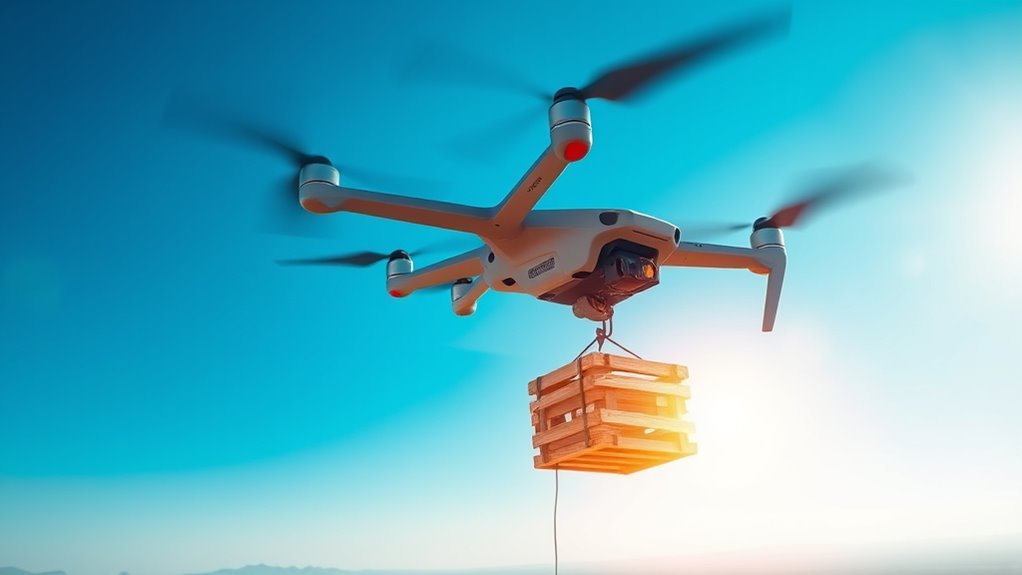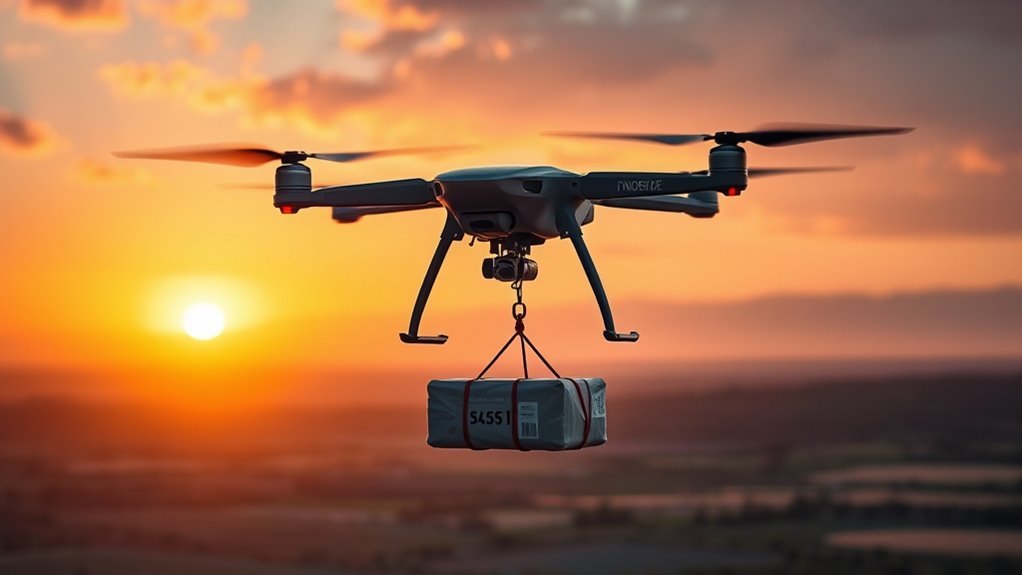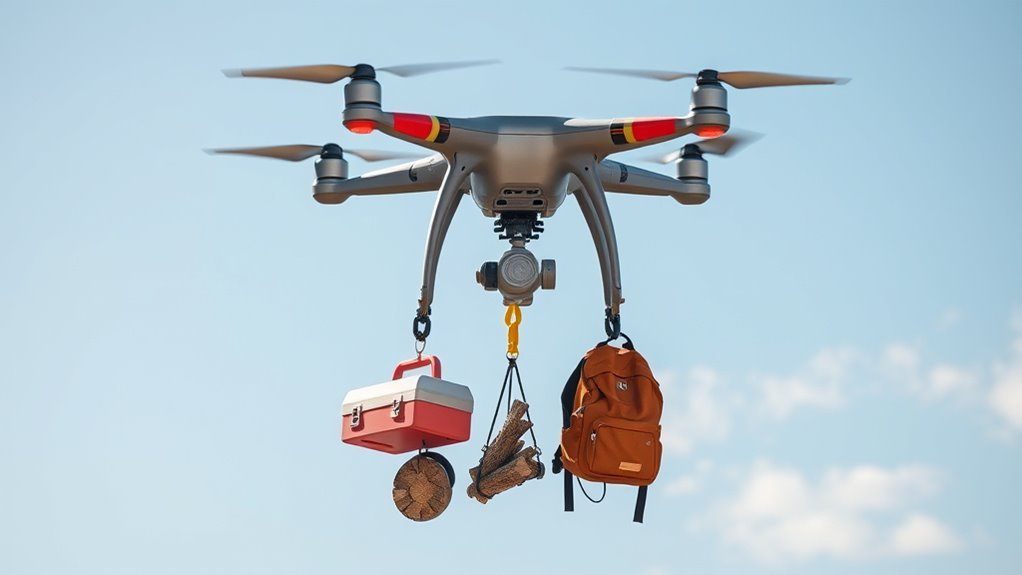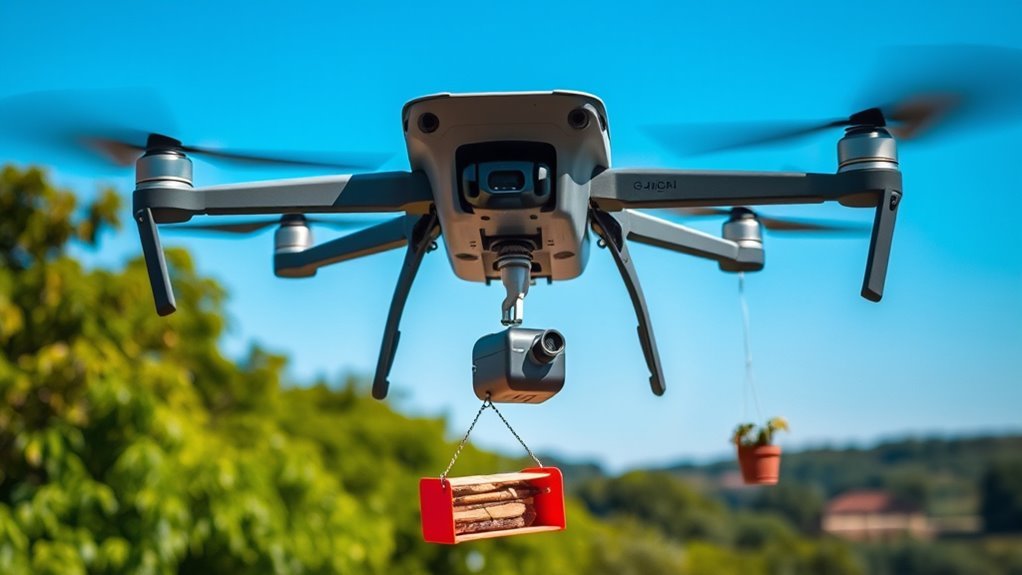Drones can lift a range of payloads depending on their type and design. Multirotors often handle lighter loads, typically a few hundred grams, while fixed-wing models can lift heavier weights, sometimes exceeding 50 kilograms. Factors like motor strength, rotor size, and weight distribution influence a drone’s lifting capacity. It’s critical to understand local regulations and manufacturer guidelines for safe payload limits. Explore further to discover more on advancements in drone technology and their implications for lifting efficiency.
Understanding Drone Payload Capacity

When you’re selecting a drone, understanding its payload capacity is crucial, as it directly influences the types of tasks it can perform. The payload capacity is determined by the drone weight and the lifting techniques employed. A drone’s maximum payload is the total weight it can safely lift without compromising performance or stability. Knowing this allows you to assess whether the drone can handle your intended applications, whether it’s aerial photography, cargo transport, or agricultural tasks. Effective lifting techniques, such as distributing weight evenly and optimizing flight speed, can enhance a drone’s efficiency. Moreover, understanding weight capacity constraints ensures that you make informed decisions regarding the materials and design of your drone to maximize its potential for various tasks, giving you the freedom to explore its capabilities. Additionally, the drone’s advanced sensor technology can significantly improve payload management by providing real-time data on weight distribution and stability during flight.
Factors Affecting Lifting Ability

When evaluating a drone’s lifting ability, you’ll need to contemplate both its design characteristics and the weight of the payload. Factors such as motor strength, frame material, and propeller size play essential roles in determining how much weight a drone can effectively carry. Additionally, exceeding recommended payload limits can considerably impair performance and stability.
Drone Design Characteristics
The lifting ability of a drone is fundamentally influenced by its design characteristics, which encompass various elements such as rotor size, weight distribution, and motor power. You’ll find that rotor size greatly affects the drone’s lifting mechanisms; larger rotors can generate more lift. Weight distribution is equally important—placing heavier components closer to the center enhances stability. The choice of drone materials also plays a key role; lightweight composites can optimize lifting capacity without compromising structural integrity. Additionally, motor power determines how effectively the drone can utilize its rotors. Understanding these design characteristics is essential for maximizing a drone’s lifting potential, allowing for innovative applications and greater freedom in aerial operations.
Payload Weight Limitations
Understanding the design characteristics that influence a drone’s lifting capabilities directly leads to an examination of payload weight limitations. Several factors affect how much weight a drone can effectively carry. Key among these are the drone’s lifting mechanisms and the efficiency of its motors. If you overload a drone, it can strain the motors, leading to reduced flight stability. Additionally, proper payload distribution is essential; uneven weight can compromise balance and maneuverability. Battery capacity also plays a significant role—higher payloads may require more energy, which could shorten flight time. Ultimately, respecting these limitations guarantees peak performance and safety, allowing you to maximize your drone’s potential without risking damage or failure.
Types of Drones and Their Capabilities

As drone technology evolves, various types of drones have emerged, each designed for specific applications and payload capacities. Understanding these drone types and their lifting mechanisms is essential for maximizing their potential. Here are three predominant categories:
- Multirotors: Known for their stability and ease of use, they excel in lifting smaller payloads, ideal for aerial photography.
- Fixed-Wing Drones: These drones can cover large distances and carry heavier loads, making them suitable for mapping and surveying tasks.
- Hybrid Drones: Combining features of multirotors and fixed-wing drones, they offer versatile lifting capabilities for various applications. Additionally, the flight time and battery performance of drones can significantly influence their lifting efficiency and operational use.
Agricultural Drones and Payload Considerations
When evaluating agricultural drones, understanding payload capacity factors is essential for optimizing crop spraying efficiency. You’ll need to take into account how weight impacts both performance and compliance with regulatory limits. Balancing these elements guarantees effective operation while adhering to safety standards. Moreover, leveraging real-time data utilization in payload management can enhance spraying efficiency and minimize waste. Additionally, considering the payload capacities of different drone models can help in selecting the most suitable option for various agricultural tasks.
Payload Capacity Factors
While the payload capacity of agricultural drones is a critical factor in their operational efficiency, several variables influence how much weight they can effectively carry. Understanding these factors can enhance your payload optimization strategies. Here are three key considerations:
- Drone Design: The structural materials and aerodynamics play a significant role in weight limits.
- Weight Distribution: Properly distributing the payload guarantees stability and efficient flight, impacting battery life and maneuverability.
- Battery Capacity: Heavier payloads require more power; therefore, the drone’s battery must be sufficient to sustain longer flights with added weight.
Crop Spraying Efficiency
Understanding crop spraying efficiency in agricultural drones requires a keen focus on payload considerations, since the amount of liquid a drone can carry directly impacts its effectiveness in field operations.
| Payload (Liters) | Crop Efficiency (%) | Aerial Application Time (Minutes) |
|---|---|---|
| 5 | 75 | 20 |
| 10 | 85 | 15 |
| 15 | 90 | 10 |
| 20 | 95 | 8 |
With the right balance of payload and crop efficiency, you can maximize the aerial application’s impact on your fields. Drones equipped for ideal payload can enhance productivity, reduce waste, and guarantee uniform coverage. In this way, you’re not just improving yields; you’re embracing freedom in how you manage your agricultural practices.
Regulatory Weight Limits
As agricultural drones increasingly play a vital role in modern farming, awareness of regulatory weight limits becomes essential for optimizing payload capabilities. Understanding these limits can guarantee regulatory compliance and enhance operational efficiency. Here are three key factors to take into account regarding weight restrictions:
- Maximum Takeoff Weight (MTOW): Each drone has a specified MTOW that includes the weight of the drone and its payload.
- Payload Capacity: Familiarize yourself with the manufacturer’s guidelines to determine the safe weight you can carry without compromising performance.
- Local Regulations: Different regions impose varying weight restrictions, so always check local laws to avoid penalties.
Drones in Construction: Lifting Heavy Materials
Drones are revolutionizing construction by efficiently lifting heavy materials, thereby streamlining workflows and enhancing safety on job sites. These unmanned aerial vehicles allow you to transport materials like bricks, tiles, and tools, reducing the need for manual labor and minimizing the risk of accidents. By integrating drones into your construction operations, you can improve construction efficiency while adhering to drone safety protocols. Their ability to reach difficult locations and deliver payloads quickly can greatly accelerate project timelines. Additionally, using drones for material handling mitigates the potential for worker injuries associated with traditional lifting methods. Adopting this technology not only promotes a safer work environment but also empowers you to focus on higher-value tasks, fostering a more productive construction process. Moreover, automated monitoring of resources allows for better allocation and utilization of materials, further enhancing efficiency on site.
Innovations in Drone Technology
While many industries have embraced drone technology, recent innovations have pushed the boundaries of what these machines can achieve. The latest drone advancements are reshaping aerial technology and expanding their capabilities. Here are three notable innovations:
- Enhanced Payload Capacity: New materials and designs allow drones to lift heavier loads, maximizing their utility across various sectors. This improvement is often facilitated by durable materials that enhance structural integrity while maintaining lightweight characteristics.
- Autonomous Navigation: Advanced sensors and AI enable drones to navigate complex environments without human intervention, enhancing efficiency and safety.
- Battery Efficiency: Innovations in battery technology have greatly extended flight times, allowing for longer missions and greater operational flexibility. The Amazon MK30’s payload capacity showcases how advancements can enhance drone functionality in delivery services.
These breakthroughs not only improve performance but also empower users to explore new applications, ultimately enhancing the freedom and versatility of drone operations.
Regulations and Limitations on Drone Payload
Given the rapid advancements in drone technology, understanding the regulations and limitations on payload capacity is essential for operators. Drone regulations vary greatly across regions, often dictating maximum weight limits for safe operation. These lifting limitations are vital in ensuring both the safety of the airspace and the integrity of the equipment. You’ll find that most countries enforce strict weight thresholds, which can restrict your operational capabilities. Additionally, compliance with local laws can impact your ability to utilize drones for commercial purposes, limiting potential profits. As you navigate these regulations, staying informed about your region’s specific requirements can empower you to maximize your drone’s payload while ensuring compliance and safety in your operations.
Future Trends in Drone Lifting Capacity
As drone technology continues to evolve, significant advancements in lifting capacity are on the horizon, driven by innovations in materials, power sources, and design. You’ll witness future innovations influenced by:
- Ultra-lightweight materials: Advanced composites and nanomaterials will reduce drone weight, enabling higher payloads without sacrificing performance.
- Battery technology: Breakthroughs in energy density will enhance flight times and lifting capabilities, allowing drones to carry heavier loads further.
- AI and automation: Emerging technologies will optimize load distribution and flight paths, maximizing efficiency and safety in lifting operations.
These trends indicate a promising future where drones not only lift more but also operate with greater autonomy and precision, ultimately expanding their role in various sectors. Embrace the potential that lies ahead!
Practical Applications of Drones in Various Industries
Drones have rapidly become indispensable tools across various industries, enhancing operational efficiency and safety. In logistics, drone delivery systems streamline last-mile transport, reducing time and costs while improving accessibility in remote areas. Aerial photography has transformed sectors like real estate, agriculture, and construction by providing high-resolution images for detailed analysis and marketing purposes. You can utilize drones for surveying vast landscapes quickly, gathering data that informs decision-making. In agriculture, drones equipped with advanced monitoring systems can detect crop threats and optimize interventions, further enhancing their utility. In emergency services, drones facilitate rapid assessments of disaster-stricken areas, offering real-time insights that save lives. As their capabilities expand, integrating drones into your operations can foster innovation, boost productivity, and create new avenues for growth, ultimately granting you the freedom to explore untapped business potential. Additionally, leveraging advanced AI integration can significantly enhance the efficiency of drone operations, enabling more effective data collection and analysis.
Frequently Asked Questions
Can Drones Lift Humans or Pets Safely?
You can’t safely lift humans or pets with drones due to drone safety regulations and human weight limits. Even advanced models lack stability and precision needed for such tasks, posing serious risks to both operators and passengers.
What Is the Heaviest Object a Consumer Drone Can Lift?
Think of a drone as a modern-day steed, galloping through the skies. Consumer drones typically have weight limits around 5 to 10 pounds, adhering to strict payload specifications that guarantee safe and efficient operation.
How Does Weather Affect a Drone’s Lifting Capacity?
Weather conditions greatly impact a drone’s lift performance. High winds, rain, or extreme temperatures can reduce stability and efficiency, limiting payload capacity. You should always assess environmental factors before determining a drone’s lifting capabilities.
Are There Drones Specifically Designed for Heavy Lifting?
Oh sure, if you think every drone’s a superhero! Heavy lift drones do exist, tailored for industrial applications. They can hoist impressive loads, revolutionizing how you think about aerial transport in tough environments.
How Do Battery Life and Payload Affect Flight Time?
Battery life and payload markedly impact flight efficiency. As payload increases, battery capacity diminishes, reducing overall flight time. Balancing these factors is essential for optimizing drone performance during missions, ensuring you maximize operational freedom.

